T.S. Rhodes's Blog, page 19
August 25, 2014
How Famous Pirates Died
“But what happened to him?” is a question that comes up at the end of many pirate stories. The end is always "he died," for the simple reason that the pirates lived 300 years ago, and no one survives that long. A better question might be “What was his fate?” Pirates seem to have been moved by fate. They came to a variety of endings.
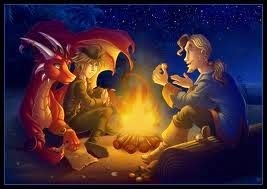
One of the first “classical” pirates, in the terms of sailing the Caribbean and taking gold from the Spanish, was Sir Francis Drake. While he is considered a naval hero by the British, he was a pirate to the Spanish he robbed, and since he stole the goods when England and Spain were not at war, he counts as a pirate here.
Drake continued his explorations until he was over fifty, an incredible age for a sailor in his day. He died of intestinal sickness on the Spanish Main, and asked to be buried at sea in full dress armor, a wish that was carried out. His expedition not only followed his wishes, they even put together a solid lead coffin for him. Divers and explorers are still searching for this coffin, which would be one of the greatest pirate “finds” of all time.
Henry Morgan, the last of the great buccaneering pirates, died on August 25th 1688. As a reward for his success in fighting the Spanish, Morgan had been knighted and made the Lieutenant Governor of Jamaica, a largely honorary position, even though there was no official governor at the time.
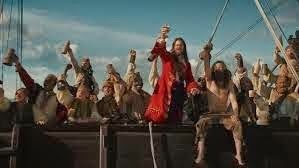
Morgan used his position to spend all his time in taverns, reliving his exploits with worshipful sailors. His death came from liver failure. He was buried in Port Royal with full military honors. Every ship in the harbor fired a salute, and the entire town took a day of mourning. Morgan’s grave was sunk beneath the sea during the Port Royal earthquake of 1692.
No one knows the fate of Henry Avery, the pirate whose carrier may be said to mark the beginning of the Golden Age of Piracy. Avery was last seen in March of 1696, in the port of New Providence in the Bahamas, where he was off-loading the incredible riches he had captured from a treasure ship of the Grand Moghul of India.
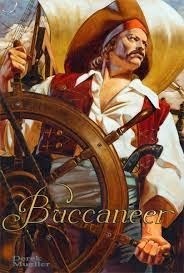
Moralists of his day claimed that he was later tricked out of his entire fortune by a dishonest merchant, and died a beggar in Bristol, England. He was also rumored to have simply changed his name and retired to a life of comfort. I have seen no evidence that proves either belief, so you may believe as you choose.
Benjamin Hornigold, the pirate teacher who influenced the careers of over a thousand pirates during the Golden Age, received a pardon for his crimes in January of 1718. This general amnesty for all pirates who agreed to stop robbing ships was a tacit agreement by the British government that they could not defeat the pirates. It was the end to many a pirating career.
Hornigold, lacking any job sills apart from captaining ships, later became a pirate hunter. He was killed when his ship ran aground in 1719.

Henry Jennings, Hornigold’s political and personal rival, also took the pardon, but he had amasses a considerable fortune as a pirate. He used this fortune to purchase a plantation in Bermuda. Jennings is widely regarded as the only pirate to enjoy a really successful retirement, and lived the life of a country gentleman until the end of his days.
Sam Bellamy, star pupil of Hornigold and one of the richest pirates at the time of his death, went down with his ship, the Whydah Galley, on April 26th, 1717 off the coast of Massachusetts in a massive storm. Of the eight pirates who escaped, six were hanged, and two (a Black man raised in the Netherlands and a half-African, half Native American) were sold into slavery.
Bellamy had supposedly been going to visit his fiancé, Mary (or Maria) Hallett. Mary was rumored to be a witch, and some said that they saw her on the headlands the night of the storm, encouraging the sea in its violence. They said she was angry at Sam for deserting her. But other claim that she was trying ot save her lover, and that the two were reunited and ran away together.

Hornigold’s other famous pupil, Blackbeard, retired successfully. He took the pardon in June of 1718, and settled in the town of Bath, North Carolina. He married a local plantation owner’s daughter, and might have lived quietly. But it seems that he became bored, and began robbing ships again.
The Royal Navy wasn’t doing enough to catch the pirates, so the Governor of Virginia offered an off-the-books reward, which lured Lieutenant Robert Maynard to bring two navy sloops and attack Blackbeard near his hideout on Oracoke Island. After a ferocious battle in which Blackbeard was wounded 26 times, Maynard at last prevailed. He hacked off Blackbeard’s head and displayed it on the bowsprit of his ship. The body was thrown overboard, where according to witnesses it swam 3 times around the ship before disappearing beneath the waves.

Some people say that the end of the Golden Age of Piracy ended in 1720, with the hanging of Calico Jack Rackham. Jack had been run down by the British navy when he and his crew were dead drunk after a night of celebration. Jack and his crew were too intoxicated to fight back, though Anne Bonny and Mary Read almost held off the entire attacking force by themselves.
Jack was tried in Jamaica and sentenced to be hanged. On November 18th, he was granted his final wish and taken to see his true love, Anne, at the door of her jail cell. She was not sympathetic, and told him that if he had fought like a man, he would not now be hanged like a dog.
Anne herself, sentenced to be hung after the birth of Jack’s child, disappeared from the jail and from history. Legend has it that she escaped, married, bore 16 children and lived to be 82 years old.
Wrecked, defeated, captured (while drunk) killed by sickness or by their own weakness, pirate made their mark upon the world. Though they may have left this earth years ago, they have, in some way, become immortal.
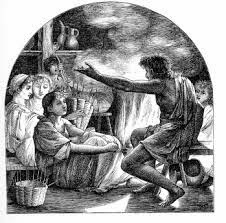

One of the first “classical” pirates, in the terms of sailing the Caribbean and taking gold from the Spanish, was Sir Francis Drake. While he is considered a naval hero by the British, he was a pirate to the Spanish he robbed, and since he stole the goods when England and Spain were not at war, he counts as a pirate here.
Drake continued his explorations until he was over fifty, an incredible age for a sailor in his day. He died of intestinal sickness on the Spanish Main, and asked to be buried at sea in full dress armor, a wish that was carried out. His expedition not only followed his wishes, they even put together a solid lead coffin for him. Divers and explorers are still searching for this coffin, which would be one of the greatest pirate “finds” of all time.
Henry Morgan, the last of the great buccaneering pirates, died on August 25th 1688. As a reward for his success in fighting the Spanish, Morgan had been knighted and made the Lieutenant Governor of Jamaica, a largely honorary position, even though there was no official governor at the time.

Morgan used his position to spend all his time in taverns, reliving his exploits with worshipful sailors. His death came from liver failure. He was buried in Port Royal with full military honors. Every ship in the harbor fired a salute, and the entire town took a day of mourning. Morgan’s grave was sunk beneath the sea during the Port Royal earthquake of 1692.
No one knows the fate of Henry Avery, the pirate whose carrier may be said to mark the beginning of the Golden Age of Piracy. Avery was last seen in March of 1696, in the port of New Providence in the Bahamas, where he was off-loading the incredible riches he had captured from a treasure ship of the Grand Moghul of India.

Moralists of his day claimed that he was later tricked out of his entire fortune by a dishonest merchant, and died a beggar in Bristol, England. He was also rumored to have simply changed his name and retired to a life of comfort. I have seen no evidence that proves either belief, so you may believe as you choose.
Benjamin Hornigold, the pirate teacher who influenced the careers of over a thousand pirates during the Golden Age, received a pardon for his crimes in January of 1718. This general amnesty for all pirates who agreed to stop robbing ships was a tacit agreement by the British government that they could not defeat the pirates. It was the end to many a pirating career.
Hornigold, lacking any job sills apart from captaining ships, later became a pirate hunter. He was killed when his ship ran aground in 1719.

Henry Jennings, Hornigold’s political and personal rival, also took the pardon, but he had amasses a considerable fortune as a pirate. He used this fortune to purchase a plantation in Bermuda. Jennings is widely regarded as the only pirate to enjoy a really successful retirement, and lived the life of a country gentleman until the end of his days.
Sam Bellamy, star pupil of Hornigold and one of the richest pirates at the time of his death, went down with his ship, the Whydah Galley, on April 26th, 1717 off the coast of Massachusetts in a massive storm. Of the eight pirates who escaped, six were hanged, and two (a Black man raised in the Netherlands and a half-African, half Native American) were sold into slavery.
Bellamy had supposedly been going to visit his fiancé, Mary (or Maria) Hallett. Mary was rumored to be a witch, and some said that they saw her on the headlands the night of the storm, encouraging the sea in its violence. They said she was angry at Sam for deserting her. But other claim that she was trying ot save her lover, and that the two were reunited and ran away together.

Hornigold’s other famous pupil, Blackbeard, retired successfully. He took the pardon in June of 1718, and settled in the town of Bath, North Carolina. He married a local plantation owner’s daughter, and might have lived quietly. But it seems that he became bored, and began robbing ships again.
The Royal Navy wasn’t doing enough to catch the pirates, so the Governor of Virginia offered an off-the-books reward, which lured Lieutenant Robert Maynard to bring two navy sloops and attack Blackbeard near his hideout on Oracoke Island. After a ferocious battle in which Blackbeard was wounded 26 times, Maynard at last prevailed. He hacked off Blackbeard’s head and displayed it on the bowsprit of his ship. The body was thrown overboard, where according to witnesses it swam 3 times around the ship before disappearing beneath the waves.

Some people say that the end of the Golden Age of Piracy ended in 1720, with the hanging of Calico Jack Rackham. Jack had been run down by the British navy when he and his crew were dead drunk after a night of celebration. Jack and his crew were too intoxicated to fight back, though Anne Bonny and Mary Read almost held off the entire attacking force by themselves.
Jack was tried in Jamaica and sentenced to be hanged. On November 18th, he was granted his final wish and taken to see his true love, Anne, at the door of her jail cell. She was not sympathetic, and told him that if he had fought like a man, he would not now be hanged like a dog.
Anne herself, sentenced to be hung after the birth of Jack’s child, disappeared from the jail and from history. Legend has it that she escaped, married, bore 16 children and lived to be 82 years old.
Wrecked, defeated, captured (while drunk) killed by sickness or by their own weakness, pirate made their mark upon the world. Though they may have left this earth years ago, they have, in some way, become immortal.

Published on August 25, 2014 18:08
August 18, 2014
How to be a Pirate
Have you ever daydreamed of actually being a pirate? Do all the stories about the Golden Age, when ships were wooden, men were iron, and everyone partied nonstop, make you long to ditch your office or your classes and run off to the Caribbean to do something illegal?

I can’t condone actually robbing people. You’ve got to remember that robbing folks is what got pirate hung in the city square. But life is about having fun, and there are some things that you can do to add a little pirate panache to your everyday life.
By all means, party. Pirates knew their lives might end any day, so they lived every day to its fullest. In today’s life, that means not sitting around the house, not getting sucked into TV or the internet. Go out… explore. Real pirates sailed from the Caribbean to Africa to Asia, just on a whim. If you can’t afford this kind of world travel, make a simple effort to get out to a nearby festival, drive to a city you’ve never visited, meet new people. (But don’t rob them.) Be a participant, not just a viewer.
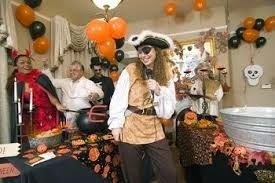
And please remember, real pirates were patrons of the arts. They performed in shipboard plays, and employed musicians. So go out and see something live! It’s part of being alive all the time, and it will enrich your life.
Real pirates were never jaded or disaffected. They had no time to be bored.
Swashbucklers during the Golden Age of Piracy did not judge others based on nationality or skin color. Pirate crews were white, black, Indian (both East and West), Chinese and even Japanese. So if you want to be more piratical, make an effort to meet and get to know a wide range of people. And don’t judge. Pirate culture was the one place, back in the day, where race, religion and even education didn’t matter.
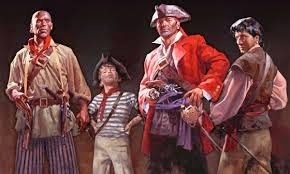
And speaking of education, it wouldn’t hurt at all to become a lifetime learner, someone with an open mind, even a philosophical bent. We have evidence that pirate ships were places where knowledge was shared, such as it was. It was a place where working class people had enough leisure to pick up skills like reading for the first time. On a higher level, the art of navigation was also taught and studied. It was important to know where the ship was. Navigation involved a lot of advanced mathematics, but these guys just tucked in and learned it.
So if you want to be more like a pirate, keep your mind open and learn what you can.
If you have a desire to fight in battles, I suggest joining the civil rights movement. Pirates left the safety of life as a common sailor because they wanted to be recognized as human, with dignity and rights, in a world that didn’t offer those things to people with little property and no fixed address. Admittedly, the world is a lot better now, but there are still many battles to be fought. Just check out the news if you doubt me.

But, you say, this isn’t as exciting as firing a cannon or waving a saber. Don’t count on that. If you belong to a group that meets in person and does work for social justice (Occupy is still a presence in many places, and there’s also Amnesty International, the NAACP, SouthernPoverty Law Center, The Innocence Project and many, many more.) you will form the same kinds of battle-forged friendships that people who have actually fought together. Fighting these fights is challenging, legal, and will help to make the world a better place.
Remember, pirates were out after justice, and went as far as putting ship’s captains on trial to decide if they deserved to be punished for treating their crews unfairly. So, in a manner of speaking, fighting for justice is one of the most piratical things you can do.
An additional thing that you can do that real pirates really would have approved of, something they fought and died to achieve, was to VOTE. Pirates, and later working-class people of all kinds, fought and died to earn the right to vote on things that affected their lives. These folks would never understand why someone who has been given the ability to vote wouldn’t use it. The fact that pirates risked their lives just to have a voice was probably one of the most amazing things that I discovered, but it’s true. Read more of this blog, or do some research on your own, and you’ll see that it’s true.
 I dress up like a pirate, and I certainly drink rum. But I also fight the good fight, take a few risks, and do my best to help out those less fortunate than myself.
I dress up like a pirate, and I certainly drink rum. But I also fight the good fight, take a few risks, and do my best to help out those less fortunate than myself.
How about you? Ready to be a pirate?
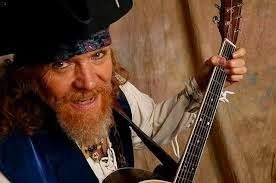

I can’t condone actually robbing people. You’ve got to remember that robbing folks is what got pirate hung in the city square. But life is about having fun, and there are some things that you can do to add a little pirate panache to your everyday life.
By all means, party. Pirates knew their lives might end any day, so they lived every day to its fullest. In today’s life, that means not sitting around the house, not getting sucked into TV or the internet. Go out… explore. Real pirates sailed from the Caribbean to Africa to Asia, just on a whim. If you can’t afford this kind of world travel, make a simple effort to get out to a nearby festival, drive to a city you’ve never visited, meet new people. (But don’t rob them.) Be a participant, not just a viewer.

And please remember, real pirates were patrons of the arts. They performed in shipboard plays, and employed musicians. So go out and see something live! It’s part of being alive all the time, and it will enrich your life.
Real pirates were never jaded or disaffected. They had no time to be bored.
Swashbucklers during the Golden Age of Piracy did not judge others based on nationality or skin color. Pirate crews were white, black, Indian (both East and West), Chinese and even Japanese. So if you want to be more piratical, make an effort to meet and get to know a wide range of people. And don’t judge. Pirate culture was the one place, back in the day, where race, religion and even education didn’t matter.

And speaking of education, it wouldn’t hurt at all to become a lifetime learner, someone with an open mind, even a philosophical bent. We have evidence that pirate ships were places where knowledge was shared, such as it was. It was a place where working class people had enough leisure to pick up skills like reading for the first time. On a higher level, the art of navigation was also taught and studied. It was important to know where the ship was. Navigation involved a lot of advanced mathematics, but these guys just tucked in and learned it.
So if you want to be more like a pirate, keep your mind open and learn what you can.
If you have a desire to fight in battles, I suggest joining the civil rights movement. Pirates left the safety of life as a common sailor because they wanted to be recognized as human, with dignity and rights, in a world that didn’t offer those things to people with little property and no fixed address. Admittedly, the world is a lot better now, but there are still many battles to be fought. Just check out the news if you doubt me.

But, you say, this isn’t as exciting as firing a cannon or waving a saber. Don’t count on that. If you belong to a group that meets in person and does work for social justice (Occupy is still a presence in many places, and there’s also Amnesty International, the NAACP, SouthernPoverty Law Center, The Innocence Project and many, many more.) you will form the same kinds of battle-forged friendships that people who have actually fought together. Fighting these fights is challenging, legal, and will help to make the world a better place.
Remember, pirates were out after justice, and went as far as putting ship’s captains on trial to decide if they deserved to be punished for treating their crews unfairly. So, in a manner of speaking, fighting for justice is one of the most piratical things you can do.

An additional thing that you can do that real pirates really would have approved of, something they fought and died to achieve, was to VOTE. Pirates, and later working-class people of all kinds, fought and died to earn the right to vote on things that affected their lives. These folks would never understand why someone who has been given the ability to vote wouldn’t use it. The fact that pirates risked their lives just to have a voice was probably one of the most amazing things that I discovered, but it’s true. Read more of this blog, or do some research on your own, and you’ll see that it’s true.
 I dress up like a pirate, and I certainly drink rum. But I also fight the good fight, take a few risks, and do my best to help out those less fortunate than myself.
I dress up like a pirate, and I certainly drink rum. But I also fight the good fight, take a few risks, and do my best to help out those less fortunate than myself.How about you? Ready to be a pirate?

Published on August 18, 2014 18:18
August 11, 2014
Two Kinds of Pirate
Pirating is one of the oldest professions, and it has been practiced all over the world. But when we think of pirates, it’s almost always the Caribbean we imagine, with its blue waters, its rum, and its bands of jolly cut-throats, who might do anything except what authority tells them to.
And yet there are two different kinds of pirates in the Caribbean, and today we’ll talk about what sets them apart from each other.

The first group falls into a period of roughly a hundred and thirty years, from about 1560 to 1688, bounded on one side by Sir Francis Drake, and on the other by Sir Henry Morgan. They included the likes of Sir John Hawkins, Sir Thomas Cavendish and Sir Humphrey Gilbert.
You may have noticed that all these men were knighted (which seems an odd fate for a pirate), evidenced by the “sir” before their names. The reason for this was that they were, at least nominally, all working for the English government, and they were most certainly sending a considerable part of their profits home to enrich that government. This sort of behavior was enough to get nearly anyone knighted, no matter what he’s been up to.
For in spite of their loyalty to their reigning monarch, they got into a lot of trouble. Drake was financed by Queen Elizabeth I to sail around the world. He was the leader of the second expedition to do it. (Magellan gets the credit for doing it first, but he didn’t live to complete the journey.) Drake made his money by sacking several Spanish galleons, and payed off his investors at a rate of 4,700%. Queen Elizabeth took her share and paid off the national debt with it.

Raleigh was also considered a pirate by the Spanish, a hero to his home country of England. He was so good at removing gold from Spanish hands that Elizabeth encouraged him to found the first colony in North America. Roanoke colony didn’t survive, and Raleigh got into considerable trouble through a secret marriage to a noblewoman. He ended up with his head cut off.
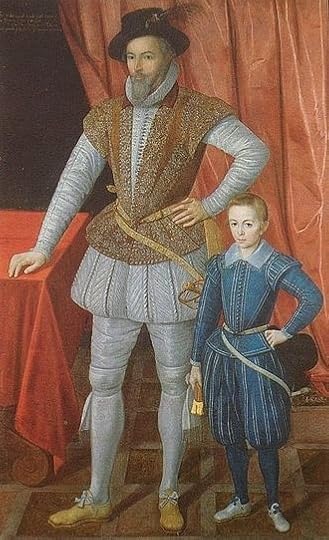
Hawkins (possibly the inspiration for the name Jim Hawkins in the novel Treasure Island) caused enough disruption that he inspired the Spanish to prohibit all English commerce in the Caribbean (a prohibition that was entirely ignored by other English adventurers.)

Morgen sailed under Letters of Marque, documents that licensed him to take specific actions against the Spanish. But he never really paid any attention to the requirements of these letters. He needed success, both for his backers and for the pirates who sailed under him, and if his assigned mission did not prove profitable he simply attacked somewhere else.
This got him into such trouble that he was recalled to England to stand trial for his disobedience. The intent was to hang him, but his many friends (men whom he had enriched) came to his aid, and he was knighted and send back to Jamaica as Lieutenant Governor, where he lived out his life hanging out in dockside taverns and drinking himself to death.
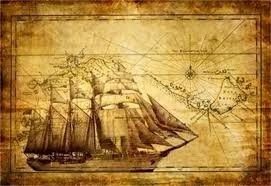
These men came from middle-class families, and had some education. They were funded by their government and by rich merchants in an era where anything was possible. Their logic seemed to be that if they were far enough away from home, they could get away with anything, and they were mostly right. In these early years, sailing in general was a communal profession. All the ship’s crew risked their lives (some voyages of exploration had 90% casualty rates) and all shared in the profits.
Often these men attacked the Spanish on land. They proved daring tacticians and inspiring leaders, as they sacked settlements and captured forts. On land they had leisure to spend days or weeks raping, burning and pillaging. To the Protestant English, the Catholic Spanish were barely human, and they had no compunction in treating them without humanity. When the Spanish, sure of their God-given rights in the New World, took revenge, a circle of torture and violence erupted.
But as time went by, sailors were expected to work for pay, and ships carrying Letters of Marque were expected to do what they were told. The Caribbean was no longer the “wild west.” Morgan’s brush with the law was a lesson to anyone who wanted to step out of line. The days of the Buccaneers were over.
Instead, corporations were beginning to rule the sea. Ships were owned by men who stayed at home, and sailed by captains who wanted their crews to work as cheaply as possible. The rise of capitalism brought about a contest between the employer and the employed. At sea pay was as small as possible, and work was all that a man could do. On land, tenant farmers who had rented the same land for generations were driven into cities, where poverty, filth and overcrowding killed them off.
In 1690 Henry Avery, a man of common birth, was being held captive by the agents of a consortium of English merchants who had sold his ship – crew and all – to the Spanish. Henry, with no family or education, raised up a band of common sailors, took the ship back and sailed her to the Indian Ocean, where he made his fortune by pirating. The Golden Age of Piracy had arrived.

Avery was a new kind of pirate. He was elected to the post of captain, and he led by the accent of his men. He refused to take more than twice the amount of plunder allotted to the lowest deck hand, and consulted his crew in all matters of importance.
Avery retired, but his story spread. When Queen Ann’s War ended, throwing thousands of sailors, with no job experience except as warriors, out of work, and the Wreck of the Spanish Treasure fleet brought adventurers from all over the world, the time was ripe.
Ben Horinigold, a former privateer, taught hundreds of young men about pirating, and along with it, the idea that working men could be free and proud. Pirate captains didn’t beat their crews. That was for the navy and the merchants. Now, when a man became a pirate, he swore to kneel before no one. The crew owned the ship, and they could vote the captain out of office. The ship was run by a set of written rules called “articles” and they applied equally to all. Never before had common men been so free.
Pirates recruited by simply asking the crews they’d captured if anyone wanted to join. And pirates were seen, more than ever before, as a danger to the established order that said some people were simply born to have more than others… More money, more respect, more freedom.

The pirate captain Bartholomew Roberts did not, at first, want to be a pirate, but when he realized the advantages of living among men who considered themselves equal, he became one of the greatest spokesmen for piracy. Sam Bellamy called himself the equal to the King of England. Captains like Charles Vane put merchant captains on trial for crimes against humanity.

The Golden Age petered out some time about 1720, when European governments realized that they could not defeat this new idea. Instead, they pardoned all the pirates, leaving them free to keep their riches and live out their lives.
Some fifty-odd years later, another upstart group in the New World would announce that “All men are created equal.”
But the pirates from the Golden Age got there first. And don’t you forget it.

And yet there are two different kinds of pirates in the Caribbean, and today we’ll talk about what sets them apart from each other.

The first group falls into a period of roughly a hundred and thirty years, from about 1560 to 1688, bounded on one side by Sir Francis Drake, and on the other by Sir Henry Morgan. They included the likes of Sir John Hawkins, Sir Thomas Cavendish and Sir Humphrey Gilbert.
You may have noticed that all these men were knighted (which seems an odd fate for a pirate), evidenced by the “sir” before their names. The reason for this was that they were, at least nominally, all working for the English government, and they were most certainly sending a considerable part of their profits home to enrich that government. This sort of behavior was enough to get nearly anyone knighted, no matter what he’s been up to.
For in spite of their loyalty to their reigning monarch, they got into a lot of trouble. Drake was financed by Queen Elizabeth I to sail around the world. He was the leader of the second expedition to do it. (Magellan gets the credit for doing it first, but he didn’t live to complete the journey.) Drake made his money by sacking several Spanish galleons, and payed off his investors at a rate of 4,700%. Queen Elizabeth took her share and paid off the national debt with it.

Raleigh was also considered a pirate by the Spanish, a hero to his home country of England. He was so good at removing gold from Spanish hands that Elizabeth encouraged him to found the first colony in North America. Roanoke colony didn’t survive, and Raleigh got into considerable trouble through a secret marriage to a noblewoman. He ended up with his head cut off.

Hawkins (possibly the inspiration for the name Jim Hawkins in the novel Treasure Island) caused enough disruption that he inspired the Spanish to prohibit all English commerce in the Caribbean (a prohibition that was entirely ignored by other English adventurers.)

Morgen sailed under Letters of Marque, documents that licensed him to take specific actions against the Spanish. But he never really paid any attention to the requirements of these letters. He needed success, both for his backers and for the pirates who sailed under him, and if his assigned mission did not prove profitable he simply attacked somewhere else.
This got him into such trouble that he was recalled to England to stand trial for his disobedience. The intent was to hang him, but his many friends (men whom he had enriched) came to his aid, and he was knighted and send back to Jamaica as Lieutenant Governor, where he lived out his life hanging out in dockside taverns and drinking himself to death.

These men came from middle-class families, and had some education. They were funded by their government and by rich merchants in an era where anything was possible. Their logic seemed to be that if they were far enough away from home, they could get away with anything, and they were mostly right. In these early years, sailing in general was a communal profession. All the ship’s crew risked their lives (some voyages of exploration had 90% casualty rates) and all shared in the profits.
Often these men attacked the Spanish on land. They proved daring tacticians and inspiring leaders, as they sacked settlements and captured forts. On land they had leisure to spend days or weeks raping, burning and pillaging. To the Protestant English, the Catholic Spanish were barely human, and they had no compunction in treating them without humanity. When the Spanish, sure of their God-given rights in the New World, took revenge, a circle of torture and violence erupted.
But as time went by, sailors were expected to work for pay, and ships carrying Letters of Marque were expected to do what they were told. The Caribbean was no longer the “wild west.” Morgan’s brush with the law was a lesson to anyone who wanted to step out of line. The days of the Buccaneers were over.
Instead, corporations were beginning to rule the sea. Ships were owned by men who stayed at home, and sailed by captains who wanted their crews to work as cheaply as possible. The rise of capitalism brought about a contest between the employer and the employed. At sea pay was as small as possible, and work was all that a man could do. On land, tenant farmers who had rented the same land for generations were driven into cities, where poverty, filth and overcrowding killed them off.
In 1690 Henry Avery, a man of common birth, was being held captive by the agents of a consortium of English merchants who had sold his ship – crew and all – to the Spanish. Henry, with no family or education, raised up a band of common sailors, took the ship back and sailed her to the Indian Ocean, where he made his fortune by pirating. The Golden Age of Piracy had arrived.

Avery was a new kind of pirate. He was elected to the post of captain, and he led by the accent of his men. He refused to take more than twice the amount of plunder allotted to the lowest deck hand, and consulted his crew in all matters of importance.
Avery retired, but his story spread. When Queen Ann’s War ended, throwing thousands of sailors, with no job experience except as warriors, out of work, and the Wreck of the Spanish Treasure fleet brought adventurers from all over the world, the time was ripe.
Ben Horinigold, a former privateer, taught hundreds of young men about pirating, and along with it, the idea that working men could be free and proud. Pirate captains didn’t beat their crews. That was for the navy and the merchants. Now, when a man became a pirate, he swore to kneel before no one. The crew owned the ship, and they could vote the captain out of office. The ship was run by a set of written rules called “articles” and they applied equally to all. Never before had common men been so free.
Pirates recruited by simply asking the crews they’d captured if anyone wanted to join. And pirates were seen, more than ever before, as a danger to the established order that said some people were simply born to have more than others… More money, more respect, more freedom.

The pirate captain Bartholomew Roberts did not, at first, want to be a pirate, but when he realized the advantages of living among men who considered themselves equal, he became one of the greatest spokesmen for piracy. Sam Bellamy called himself the equal to the King of England. Captains like Charles Vane put merchant captains on trial for crimes against humanity.

The Golden Age petered out some time about 1720, when European governments realized that they could not defeat this new idea. Instead, they pardoned all the pirates, leaving them free to keep their riches and live out their lives.
Some fifty-odd years later, another upstart group in the New World would announce that “All men are created equal.”
But the pirates from the Golden Age got there first. And don’t you forget it.

Published on August 11, 2014 18:00
August 4, 2014
Pirates and Pasta - The Church of the Flying Spaghetti Monster
“Global warming, earthquakes, hurricanes, and other natural disasters are a direct effect of the shrinking numbers of Pirates since the 1800s. For your interest, I have included a graph of the approximate number of pirates versus the average global temperature over the last 200 years. As you can see, there is a statistically significant inverse relationship between pirates and global temperature.”

What madness is this?
Fear not, good friends. There is no madness here. It’s not some person with no grasp of cause and effect. It’s the Church of the Flying Spaghetti Monster!
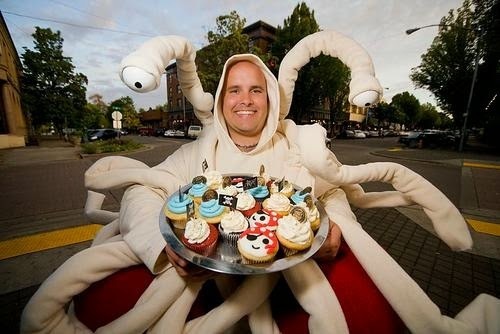
In 2005, Bobby Henderson, a physics student and proponent of common sense, learned that the Kansas School Board was considering whether or not to include the “alternate theory” of Intelligent Design in the school curriculum.
Bobby believes in science, and he also believes in logic. And logic says that, if you are going to teach one “alternate theory” of creation, you need to teach them all. He whipped out a letter to the Kansas School Board illustrating just how silly the religious argument sounds to those not indoctrinated into that religion, and sent it off. When he received no answer, he posted it on line.
Soon hundreds, then thousands of people wanted to know more about the Spaghetti Monster, his religion, Pastafarianism and his chosen people, the pirates. As the phenomenon grew, serious science and religious groups such as the American Academy of Religions began using the concept of the FSM as a tool to discuss issues such as “What is a religion?”
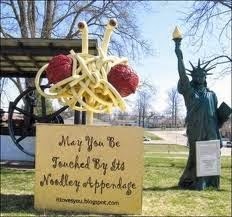
And so a religion was born.
Henderson had only meant to create one piece of satire, but scientists, bloggers, and a general host of those who worry about the way schools are encouraged to teach religion made the Church of the Flying Spaghetti Monster a talking point to explain how:
1. It’s impossible to disprove the existence of ANY invisible, all-powerful being that does not want to be seen, and how this puts the burden of proof on the believer (if proof is required.)
2. Correlation (the fact that some things happen at the same time as others) is not the same as Causation (some things being caused by others.
3. Gravity is “just a theory, too.” (Pastafarians believe that gravity does not exist, and that we are held to the earth by the Noodly Appendages of the FSM.)
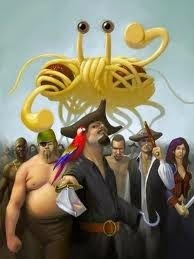
Hence, the talk about how a lack of pirates “causes” Global Warming. Conveniently, Somalia - home to modern day pirates – has some of the lowest carbon emissions on the planet. Though it’s actually caused by the kind of civil unrest and governmental decay that drives people to become pirates, it’s a nice touch.
Soon, Bobby created the Gospel of the Flying Spaghetti Monster, an official religious book for the organization (recognized as such by the US Army) and the 7 “I’d Really Rather You Didn’t –s.” He claimed that heaven is where there is plenty of beer and strippers (both male and female, gay and straight) and that hell is where the beer is flat and the strippers have VD.
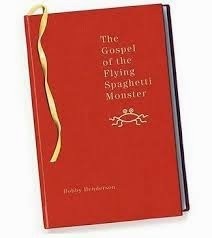
This signaled a new development in the church’s history. Fun loving people were wanted the trappings of a “real” religion. But Bobby’s writings are carefully non-sexist, non-dogmatic. He informs his readers that, spiritually, there is no difference between men and women, and urges them to “Just play nice, okay?”
Many who are drawn to the FSM because of the elements of parody in the Church stay because of this officially sanctioned plea for rationality. The FSM has been carried in countless parades, and bowls of pasta have appeared at serious political protests in Eastern Europe, symbolizing the importance of personal belief, rather than religious dogma.

The Church of the Flying Spaghetti Monster is popular at college campuses, possibly because the Church teaches that the reason the world is so messed up is that the FSM created it while drunk. With the energy and passion associated with young people, the students (and some older folk) dress as pirates in order to spread the word.
You see, it’s absolutely required that, in respect for the original pirates, those who talk about the faith must dress in full pirate regalia (or at least an eye patch).
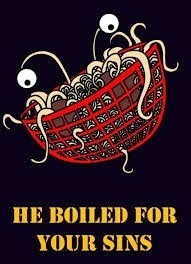
What’s the point? Fun, in part. But fun with a purpose. Pirates have always symbolized the rejection of authoritarianism. To those who feel that a smaller and smaller group of religious fanatics is having a greater and greater effect on the way the world is run, the Spaghetti Monster is a benevolent, humorous form of protest. It’s also an enjoyable snack.
In addition, the Church of the Flying Spaghetti Monster is the number one contributor to its chosen charity, the micro-lending site KIVA, which funds third world farms and businesses.
Plans to build a pirate ship are on hold right now.

What madness is this?
Fear not, good friends. There is no madness here. It’s not some person with no grasp of cause and effect. It’s the Church of the Flying Spaghetti Monster!

In 2005, Bobby Henderson, a physics student and proponent of common sense, learned that the Kansas School Board was considering whether or not to include the “alternate theory” of Intelligent Design in the school curriculum.
Bobby believes in science, and he also believes in logic. And logic says that, if you are going to teach one “alternate theory” of creation, you need to teach them all. He whipped out a letter to the Kansas School Board illustrating just how silly the religious argument sounds to those not indoctrinated into that religion, and sent it off. When he received no answer, he posted it on line.
Soon hundreds, then thousands of people wanted to know more about the Spaghetti Monster, his religion, Pastafarianism and his chosen people, the pirates. As the phenomenon grew, serious science and religious groups such as the American Academy of Religions began using the concept of the FSM as a tool to discuss issues such as “What is a religion?”

And so a religion was born.
Henderson had only meant to create one piece of satire, but scientists, bloggers, and a general host of those who worry about the way schools are encouraged to teach religion made the Church of the Flying Spaghetti Monster a talking point to explain how:
1. It’s impossible to disprove the existence of ANY invisible, all-powerful being that does not want to be seen, and how this puts the burden of proof on the believer (if proof is required.)
2. Correlation (the fact that some things happen at the same time as others) is not the same as Causation (some things being caused by others.
3. Gravity is “just a theory, too.” (Pastafarians believe that gravity does not exist, and that we are held to the earth by the Noodly Appendages of the FSM.)

Hence, the talk about how a lack of pirates “causes” Global Warming. Conveniently, Somalia - home to modern day pirates – has some of the lowest carbon emissions on the planet. Though it’s actually caused by the kind of civil unrest and governmental decay that drives people to become pirates, it’s a nice touch.
Soon, Bobby created the Gospel of the Flying Spaghetti Monster, an official religious book for the organization (recognized as such by the US Army) and the 7 “I’d Really Rather You Didn’t –s.” He claimed that heaven is where there is plenty of beer and strippers (both male and female, gay and straight) and that hell is where the beer is flat and the strippers have VD.

This signaled a new development in the church’s history. Fun loving people were wanted the trappings of a “real” religion. But Bobby’s writings are carefully non-sexist, non-dogmatic. He informs his readers that, spiritually, there is no difference between men and women, and urges them to “Just play nice, okay?”
Many who are drawn to the FSM because of the elements of parody in the Church stay because of this officially sanctioned plea for rationality. The FSM has been carried in countless parades, and bowls of pasta have appeared at serious political protests in Eastern Europe, symbolizing the importance of personal belief, rather than religious dogma.

The Church of the Flying Spaghetti Monster is popular at college campuses, possibly because the Church teaches that the reason the world is so messed up is that the FSM created it while drunk. With the energy and passion associated with young people, the students (and some older folk) dress as pirates in order to spread the word.
You see, it’s absolutely required that, in respect for the original pirates, those who talk about the faith must dress in full pirate regalia (or at least an eye patch).

What’s the point? Fun, in part. But fun with a purpose. Pirates have always symbolized the rejection of authoritarianism. To those who feel that a smaller and smaller group of religious fanatics is having a greater and greater effect on the way the world is run, the Spaghetti Monster is a benevolent, humorous form of protest. It’s also an enjoyable snack.
In addition, the Church of the Flying Spaghetti Monster is the number one contributor to its chosen charity, the micro-lending site KIVA, which funds third world farms and businesses.
Plans to build a pirate ship are on hold right now.
Published on August 04, 2014 19:40
July 28, 2014
Evil Pirates
Warning - Not for the Squeamish.Anyone who reads this blog regularly knows that I don’t think most pirates were evil. Pirates – especially during the Golden Age – were men who had given up on an employment system that was vastly unfair to them, and simply refused to abide by the rules that oppressed them. They didn’t get an “evil card” when they became pirates. Instead, their essential likes, dislikes and temperaments remained the same.
And because of this, pirates tended to like and to do the same things most sailors did. They liked flashy clothes and good food, and tended to drink too much and spend money on pretty women.
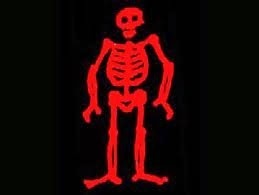
But there was definitely a darker side to the pirate life. There was literally no punishment worse than the one for piracy. And so these men were free from all the constraints of law and order. Every man who became a pirate was under a death sentence as soon as he robbed his first ship. And since he could not face any worse punishment, there was no reason not to rape, kill or torture, if the mood took him.
It’s a tribute to the general moral goodness of humanity that most pirates were well behaved.
Most of the mayhem caused by early pirate captains was aimed at races or cultures other than their own. The 1600’s were an age of religious wars and extreme xenophobia. Religious and political leaders defined people of other religions or cultures as sub-human, and they were believed by the masses.
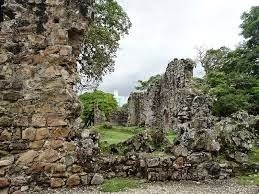
When men like Henry Morgan confronted the Spanish he was meeting Catholics, and as a Protestant he had no reason to think of them as in any way like himself. So Morgan, a friendly man, loved by his crews and comrades, made a career of destroying Spanish towns, looting, burning, pillaging and raping. He destroyed Panama City so utterly that it was rebuilt in a different location (its present one). Morgan and his men tortured the Spanish citizens to persuade them to give up their treasures. Morgan carried out his missions against any Spanish town that seemed convenient, whether he had official permission from his government to do so or not.
When back in port, among his own people, he was a peaceful if somewhat rough-hewn gentleman.
French pirate François l'Olonnais had a personal vendetta against the Spanish, as they wiped out almost all of his crew during his early career. L’Olonnais only survived by covering himself in the blood of his slaughtered men and hiding among the dead. After that, he burned all the Spanish ships he captured.
 One crew of a Spanish naval ship was entirely beheaded. L’Olonnais left one man alive and sent him back to the Spanish government with a warning.
One crew of a Spanish naval ship was entirely beheaded. L’Olonnais left one man alive and sent him back to the Spanish government with a warning.
When he sacked the Spanish town of Maracaibo, he found that most of the inhabitants had hidden their valuables and fled. The pirates tracked down the citizens and tortured them until they revealed the locations of the money. L’Olonnais was an expert torturer, who favored cutting pieces off his victims with a sword, tightening rope around their heads until their eyes popped out, and tying burning rope to their hands.
When l’Olonnais’ crew took the Venezuelan town of Gibraltar, his men slaughtered the garrison, held the town for ransom, and when the ransom was paid, stayed in the town for over two months, raping, burning and pillaging. The town was effectively destroyed. In the next 350 years it has never recovered.
When faced with near-capture, he and his men caught several Spanish soldiers, and needed to persuade them to reveal the safest escape route. L’Olonnais wasted no time. He hacked one soldier’s living heart out of his chest and ate it in front of the dying man’s eyes. The rest of the soldiers were happy to cooperate with the pirates.
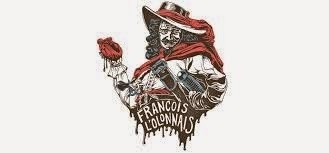
During the Golden Age, pirates dedicated to finding justice for oppressed sailors (including themselves) set up courts of honor to punish merchant captains who had mistreated their crews, and the fate of these men could be dire. One captain who had formerly refused to pay his crews found himself tied to the capstan and pelted with broken bottles. Finally, when he was terrified and streaming blood, a member of his former crew stepped up to him, told him that he wasn’t such a bad fellow, and shot him in the head. He died instantly.
Other men were forced to run around the base of the ship’s mainmast while the pirate crew stabbed at them with knives, forks, compass cases, pen-sharpeners and swords. The buttocks were the favored target, but such abuse could still do substantial damage.

Some merchant captains were hanged from their own yardarms.
The most notorious of the Golden Age pirates was probably Edward Low, a former pickpocket and strong-arm thief who went to sea in his late teens. Low was probably a sociopath, who used his love of torture to improve his reputation as a bloodthirsty marauder. By leading an attempted mutiny, Low took his career straight from deck-hand to captain. His own men described him as “a maniac and a brute.”
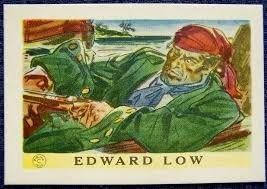 His most famous action was cutting a Portuguese captain’s lips off, cooking them, and forcing their owner to eat them.
His most famous action was cutting a Portuguese captain’s lips off, cooking them, and forcing their owner to eat them.
He burned a French cook alive, saying “He’s a greasy fellow who will fry well.”
Low also liked to torture victims, often for no particular reason. He counted on his reputation creating so much terror that the crews of merchant, and even navy ships would be too frightened to attack him. When the authorities placed a huge bounty on his head, the Caribbean became too hot, and Low moved his operations north to attack the New England whaling fleet.
He immediately began by torturing and murdering the captain of a whaler, and went on wreaking havoc among the fishing ships until his own crew refused to sail with him, and put him off in a smaller boat.
Low’s ultimate fate remains uncertain. Some sources say that his own (smaller) crew eventually killed him over his murder of one of his own men. Others think that he went down in a storm, or was caught by the French and hanged in Martinique. There is even some evidence that he landed on the coast of Brazil and lived his life out there, though this seems unlikely for such a violent man.
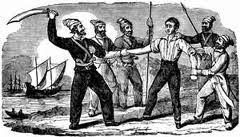
The seventeenth and eighteenth centuries were a bloody and violent time, and pirates like these made it more so. But it’s important to remember that, even among their own law-breaking comrades, they were exceptions to the rule. Pirates were human, just like the rest of us, with a wide variety of personalities and behaviors.
And because of this, pirates tended to like and to do the same things most sailors did. They liked flashy clothes and good food, and tended to drink too much and spend money on pretty women.

But there was definitely a darker side to the pirate life. There was literally no punishment worse than the one for piracy. And so these men were free from all the constraints of law and order. Every man who became a pirate was under a death sentence as soon as he robbed his first ship. And since he could not face any worse punishment, there was no reason not to rape, kill or torture, if the mood took him.
It’s a tribute to the general moral goodness of humanity that most pirates were well behaved.
Most of the mayhem caused by early pirate captains was aimed at races or cultures other than their own. The 1600’s were an age of religious wars and extreme xenophobia. Religious and political leaders defined people of other religions or cultures as sub-human, and they were believed by the masses.

When men like Henry Morgan confronted the Spanish he was meeting Catholics, and as a Protestant he had no reason to think of them as in any way like himself. So Morgan, a friendly man, loved by his crews and comrades, made a career of destroying Spanish towns, looting, burning, pillaging and raping. He destroyed Panama City so utterly that it was rebuilt in a different location (its present one). Morgan and his men tortured the Spanish citizens to persuade them to give up their treasures. Morgan carried out his missions against any Spanish town that seemed convenient, whether he had official permission from his government to do so or not.
When back in port, among his own people, he was a peaceful if somewhat rough-hewn gentleman.
French pirate François l'Olonnais had a personal vendetta against the Spanish, as they wiped out almost all of his crew during his early career. L’Olonnais only survived by covering himself in the blood of his slaughtered men and hiding among the dead. After that, he burned all the Spanish ships he captured.
 One crew of a Spanish naval ship was entirely beheaded. L’Olonnais left one man alive and sent him back to the Spanish government with a warning.
One crew of a Spanish naval ship was entirely beheaded. L’Olonnais left one man alive and sent him back to the Spanish government with a warning.When he sacked the Spanish town of Maracaibo, he found that most of the inhabitants had hidden their valuables and fled. The pirates tracked down the citizens and tortured them until they revealed the locations of the money. L’Olonnais was an expert torturer, who favored cutting pieces off his victims with a sword, tightening rope around their heads until their eyes popped out, and tying burning rope to their hands.
When l’Olonnais’ crew took the Venezuelan town of Gibraltar, his men slaughtered the garrison, held the town for ransom, and when the ransom was paid, stayed in the town for over two months, raping, burning and pillaging. The town was effectively destroyed. In the next 350 years it has never recovered.
When faced with near-capture, he and his men caught several Spanish soldiers, and needed to persuade them to reveal the safest escape route. L’Olonnais wasted no time. He hacked one soldier’s living heart out of his chest and ate it in front of the dying man’s eyes. The rest of the soldiers were happy to cooperate with the pirates.

During the Golden Age, pirates dedicated to finding justice for oppressed sailors (including themselves) set up courts of honor to punish merchant captains who had mistreated their crews, and the fate of these men could be dire. One captain who had formerly refused to pay his crews found himself tied to the capstan and pelted with broken bottles. Finally, when he was terrified and streaming blood, a member of his former crew stepped up to him, told him that he wasn’t such a bad fellow, and shot him in the head. He died instantly.
Other men were forced to run around the base of the ship’s mainmast while the pirate crew stabbed at them with knives, forks, compass cases, pen-sharpeners and swords. The buttocks were the favored target, but such abuse could still do substantial damage.

Some merchant captains were hanged from their own yardarms.
The most notorious of the Golden Age pirates was probably Edward Low, a former pickpocket and strong-arm thief who went to sea in his late teens. Low was probably a sociopath, who used his love of torture to improve his reputation as a bloodthirsty marauder. By leading an attempted mutiny, Low took his career straight from deck-hand to captain. His own men described him as “a maniac and a brute.”
 His most famous action was cutting a Portuguese captain’s lips off, cooking them, and forcing their owner to eat them.
His most famous action was cutting a Portuguese captain’s lips off, cooking them, and forcing their owner to eat them.He burned a French cook alive, saying “He’s a greasy fellow who will fry well.”
Low also liked to torture victims, often for no particular reason. He counted on his reputation creating so much terror that the crews of merchant, and even navy ships would be too frightened to attack him. When the authorities placed a huge bounty on his head, the Caribbean became too hot, and Low moved his operations north to attack the New England whaling fleet.
He immediately began by torturing and murdering the captain of a whaler, and went on wreaking havoc among the fishing ships until his own crew refused to sail with him, and put him off in a smaller boat.
Low’s ultimate fate remains uncertain. Some sources say that his own (smaller) crew eventually killed him over his murder of one of his own men. Others think that he went down in a storm, or was caught by the French and hanged in Martinique. There is even some evidence that he landed on the coast of Brazil and lived his life out there, though this seems unlikely for such a violent man.

The seventeenth and eighteenth centuries were a bloody and violent time, and pirates like these made it more so. But it’s important to remember that, even among their own law-breaking comrades, they were exceptions to the rule. Pirates were human, just like the rest of us, with a wide variety of personalities and behaviors.
Published on July 28, 2014 17:13
July 21, 2014
How to Throw a Pirate Party (for Kids)
Last week I shared some of my secrets for throwing a grown-up pirate party, and this week we’ll talk about how to share some pirate fun with the little ones.
Of course, anyone can go to the party store and buy the latest “Jake and the Neverland Pirates” partyware, pick up a piñata, and then pop a movie into the TV. And for some kids – the very young, the shy, or the ones who don’t deal well with unusual happenings - this might be the best thing. You need to know your own child, and your child's friends, and understand what they will like.
 But for the older kids, the slightly more adventuresome, I’ve got a list of things to make a party memorable. Sure, you could use skull-and-crossbones plates. But the kids might enjoy the more exotic feel of eating off wooden salad bowls. The words “Just like real pirates” can be tossed around when passing these out. And instead of paper cups, go to the dollar store and get plastic wine glasses or big plastic mugs. If you hit the store at the right season, you might even be able to get fake coconuts with straws. Not only will this add spice to the food, but the fancy cups make a nice take-home treat.
But for the older kids, the slightly more adventuresome, I’ve got a list of things to make a party memorable. Sure, you could use skull-and-crossbones plates. But the kids might enjoy the more exotic feel of eating off wooden salad bowls. The words “Just like real pirates” can be tossed around when passing these out. And instead of paper cups, go to the dollar store and get plastic wine glasses or big plastic mugs. If you hit the store at the right season, you might even be able to get fake coconuts with straws. Not only will this add spice to the food, but the fancy cups make a nice take-home treat.
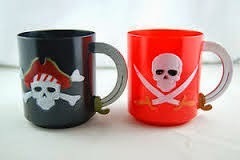
You can take a hint from the grown-up decorations. Thrift-store fabrics draped around the house, covering tables and TV’s is cheap, will protect your house, absorb spills, and you can throw them away if you want afterwards. You can also rummage through your Halloween decorations. Kids love skulls, chains and anything that looks like fire. (I’m thinking fake electric candles, and the Halloween effect where a tiny fan flutters streamers, and a red light makes it look like fire – usually as a torch or a cauldron of fire. No real flames for the little guys.)
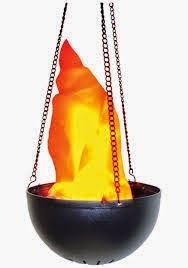
You can buy a big pirate flag on-line for less than five dollars. Or you can print out a variety of pirate flag pictures.
The kids may enjoy having the bathroom labeled “poop deck” or the kitchen labeled “galley” In fact, just printing out piratey words like “Avast!” “Belay!” “Starboard” “Port” “Shiver me timbers” “Pieces of Eight” in a cool typeface would make good decorations, if the kids are old enough to read. I use Blackadder, which came with my computer.
A good kid’s party often includes a craft, and I can offer a couple that you may not have seen before. First is this lovely hand print pirate and parrot. It may be a little messy, but that’s why you have all the fabric draped around.
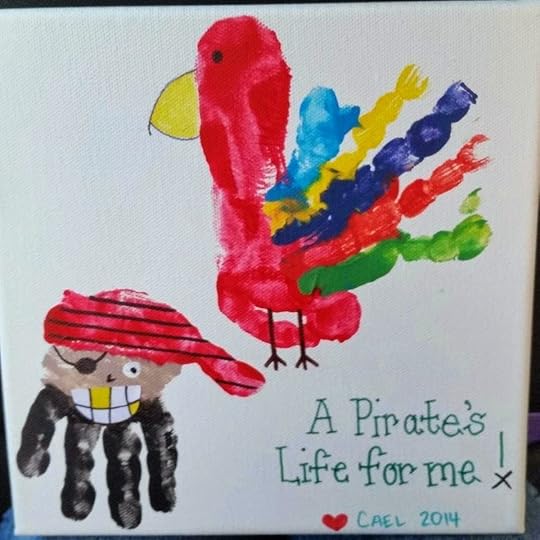
Craft number two is making your own pirate flag. The prep for this involves pre-cutting flag shapes out of black felt – they won’t need to be hemmed. The kids will paint their flags with regular acrylic craft paint, and you don’t need too many colors. Red and white will probably do, though you might want to add black for painting over mistakes.
*Hint – if you want to paint a skull, start by drawing two circles side by side (eyes), and a point-up triangle (nose) right below them. Surround all of this with a sideways oval (outside of head) and color it in. Then paint lines down from the skull to make teeth.
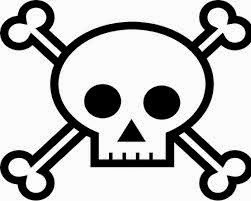
Games are also a staple of kid’s parties. Outside, a tug-of-war would be a great piratey game, and if you have a big yard and don’t mind digging a hole, you could even bury a treasure and make a map. If you don’t have a big yard, and this idea really appeals to you, bury your treasure in a flowerpot or hide it. Gold pirate coins can be bought in party stores, and really nice wooden “pirate” chests can be found at Michaels craft stores or JoAnn fabric and craft stores. Go on line and get a coupon – it will save you about 50%.
On a much simpler note, I’ve also used a game I call “island hopping.” Cut random shapes from craft paper or felt – each about 18” across, and at least one per child. Play music, and let the kids hop from “island” to “island”, stopping the music from time to time so everyone has to pick a spot. If you like, you can remove one island ever time, like musical chairs, though I found the kids just liked jumping, and didn’t need it to be a competition.

You can buy a CD of children’s pirate songs online, or check out your local library. I recommend “Pirates of the Caribbean- Swashbuckling Sea Songs” though there are many others as well. Please note – if the CD is not specifically aimed at children, beware! A lot of sea songs are “salty” and you may have some explaining to do if you don’t choose versions made for children.
The kids may enjoy singing along, too. Pick a simple tune like “Yo Ho, Yo Ho A Pirate’s Life for Me” and encourage lots of loud voices! Kids love to sing, and your pirate songs may be the most memorable part of your party.
Kid’s parties end with food and cake. Fruit salad is a good idea, and rounds of bread can be “ship’s biscuit.” Kids also love “meat on a stick” which is nothing more than chicken strips on skewers, grilled and served with dipping sauce. Once again, though, know your guests! Some kids will eat nothing but chicken nuggets.
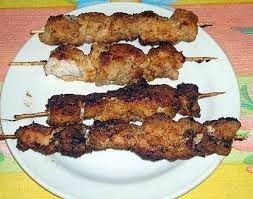
You can order a cake or you can make one. I’m no baker, but I can put together a craft project. So here’s a link to a pirate ship cake that’s made from cake mix and sculpted very simply.
Is this a lot of work? Yes. But it can be the coolest party ever. I hope you enjoy throwing it, and that your kids remember the pirate fun for years to come. (Oh, and if you throw the party, I’d love to see pictures!)

Of course, anyone can go to the party store and buy the latest “Jake and the Neverland Pirates” partyware, pick up a piñata, and then pop a movie into the TV. And for some kids – the very young, the shy, or the ones who don’t deal well with unusual happenings - this might be the best thing. You need to know your own child, and your child's friends, and understand what they will like.
 But for the older kids, the slightly more adventuresome, I’ve got a list of things to make a party memorable. Sure, you could use skull-and-crossbones plates. But the kids might enjoy the more exotic feel of eating off wooden salad bowls. The words “Just like real pirates” can be tossed around when passing these out. And instead of paper cups, go to the dollar store and get plastic wine glasses or big plastic mugs. If you hit the store at the right season, you might even be able to get fake coconuts with straws. Not only will this add spice to the food, but the fancy cups make a nice take-home treat.
But for the older kids, the slightly more adventuresome, I’ve got a list of things to make a party memorable. Sure, you could use skull-and-crossbones plates. But the kids might enjoy the more exotic feel of eating off wooden salad bowls. The words “Just like real pirates” can be tossed around when passing these out. And instead of paper cups, go to the dollar store and get plastic wine glasses or big plastic mugs. If you hit the store at the right season, you might even be able to get fake coconuts with straws. Not only will this add spice to the food, but the fancy cups make a nice take-home treat.
You can take a hint from the grown-up decorations. Thrift-store fabrics draped around the house, covering tables and TV’s is cheap, will protect your house, absorb spills, and you can throw them away if you want afterwards. You can also rummage through your Halloween decorations. Kids love skulls, chains and anything that looks like fire. (I’m thinking fake electric candles, and the Halloween effect where a tiny fan flutters streamers, and a red light makes it look like fire – usually as a torch or a cauldron of fire. No real flames for the little guys.)

You can buy a big pirate flag on-line for less than five dollars. Or you can print out a variety of pirate flag pictures.
The kids may enjoy having the bathroom labeled “poop deck” or the kitchen labeled “galley” In fact, just printing out piratey words like “Avast!” “Belay!” “Starboard” “Port” “Shiver me timbers” “Pieces of Eight” in a cool typeface would make good decorations, if the kids are old enough to read. I use Blackadder, which came with my computer.
A good kid’s party often includes a craft, and I can offer a couple that you may not have seen before. First is this lovely hand print pirate and parrot. It may be a little messy, but that’s why you have all the fabric draped around.

Craft number two is making your own pirate flag. The prep for this involves pre-cutting flag shapes out of black felt – they won’t need to be hemmed. The kids will paint their flags with regular acrylic craft paint, and you don’t need too many colors. Red and white will probably do, though you might want to add black for painting over mistakes.
*Hint – if you want to paint a skull, start by drawing two circles side by side (eyes), and a point-up triangle (nose) right below them. Surround all of this with a sideways oval (outside of head) and color it in. Then paint lines down from the skull to make teeth.

Games are also a staple of kid’s parties. Outside, a tug-of-war would be a great piratey game, and if you have a big yard and don’t mind digging a hole, you could even bury a treasure and make a map. If you don’t have a big yard, and this idea really appeals to you, bury your treasure in a flowerpot or hide it. Gold pirate coins can be bought in party stores, and really nice wooden “pirate” chests can be found at Michaels craft stores or JoAnn fabric and craft stores. Go on line and get a coupon – it will save you about 50%.
On a much simpler note, I’ve also used a game I call “island hopping.” Cut random shapes from craft paper or felt – each about 18” across, and at least one per child. Play music, and let the kids hop from “island” to “island”, stopping the music from time to time so everyone has to pick a spot. If you like, you can remove one island ever time, like musical chairs, though I found the kids just liked jumping, and didn’t need it to be a competition.

You can buy a CD of children’s pirate songs online, or check out your local library. I recommend “Pirates of the Caribbean- Swashbuckling Sea Songs” though there are many others as well. Please note – if the CD is not specifically aimed at children, beware! A lot of sea songs are “salty” and you may have some explaining to do if you don’t choose versions made for children.
The kids may enjoy singing along, too. Pick a simple tune like “Yo Ho, Yo Ho A Pirate’s Life for Me” and encourage lots of loud voices! Kids love to sing, and your pirate songs may be the most memorable part of your party.
Kid’s parties end with food and cake. Fruit salad is a good idea, and rounds of bread can be “ship’s biscuit.” Kids also love “meat on a stick” which is nothing more than chicken strips on skewers, grilled and served with dipping sauce. Once again, though, know your guests! Some kids will eat nothing but chicken nuggets.

You can order a cake or you can make one. I’m no baker, but I can put together a craft project. So here’s a link to a pirate ship cake that’s made from cake mix and sculpted very simply.
Is this a lot of work? Yes. But it can be the coolest party ever. I hope you enjoy throwing it, and that your kids remember the pirate fun for years to come. (Oh, and if you throw the party, I’d love to see pictures!)

Published on July 21, 2014 19:28
July 15, 2014
How to Throw a Pirate Party (for Adults)
Okay, the easy answer is “rum.” But it so happens that I throw a pirate party every year that is completely alcohol free, and it’s so popular that people start asking about it six months in advance. Whether or not you choose to add alcohol is your own business. Here’s how to do the rest of it.
First: the Decorations
It so happens that, as a semi-professional pirate myself, I have a lot of piratical stuff. A couple of Megablocks pirate ships, Jack Sparrow posters, pirate flags, chests, and a lot of others, right down to my pirate rubber duck.
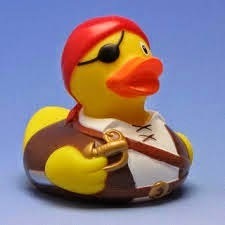
So it you love pirates, and you have this stuff, make sure it’s all out where people can see it.
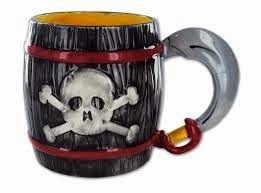
But to buy new stuff for decorations, go to the second-hand store. First, stock up on fabric – second hand sheets, old lace, brocade and checked table cloths, patterned curtains. These are what you will use to cover up the modern stuff in your house that you can’t hide. Modern furniture, appliances, desks, all get hidden under a couple of layers of cloth. Why a couple? Because you don’t want to be neat. Use at least two layers, and make sure they don’t match and neither one is straight. You want it to look like someone just casually threw the cloth over what-ever-it-is.

I like to light most of my house with candles for effect, and this means no exposed flames (too dangerous) so the candles need to go inside glasses, jelly jars, anything that will protect your guests. (More stuff you can find in the second hand store.)
Be careful people! And if you want the effect, but not the fire, get the fake candles that operate off a small battery.

This is also where you get your serving trays and bowls, and the plates and cups your guests will use. Oh, sure, anyone can buy paper plates with a jolly roger on them. But when your guests are eating off a mish-mash of wooden salad bowls, fine china plates, and weird little silver or glass trays, and drinking out of beer steins, wine glasses and teacups, they’ll feel like they’re in the home of outlaws.
It’s also cheaper. I serve food off wooden cutting boards and salad bowls, glass punch bowls, cast iron pots, fine china serving pieces. All bought at next-to-nothing second hand.
I went on line and printed out large (11x17) versions of various pirate pictures, and framed them before hanging them up. Fishing nets (from Michaels craft store) add a nautical touch. I fill jewelry boxes with fake gold coins (party store) and garage-sale jewelry.
Food:
I love to feed my guests, but what’s appropriate pirate food? My theory is that pirates traveled all over, so I should try to have food from all the places that pirates hung out: a mix of Chinese, Mexican, French, Irish, African and North American food, with a little tropical thrown in for fun.

If you don’t cook, it could be: mini egg rolls (China), salsa, guacamole and chips (Mexico) French silk pie,(France) potato skins (“Irish”), popcorn (North America), tropical fruit salad (you can buy this canned, if you REALLY don’t make food), coconut cookies. And my favorite pirate food: Meat on a Stick. This is just chicken or pork, threaded on wooden skewers (from the grocery store) and grilled or baked. Barbecue sauce is perfectly acceptable, since both barbecue and buccaneer come from the same root word, which also gives us “bacon.” So throw some bacon in there as well.
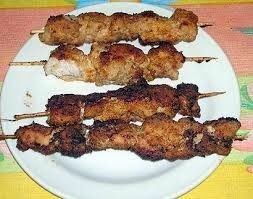
Alcoholic punch was popular when pirates ruled the seas, so I always do punch, though mine has no alcohol. There are so many recipes you can surely find one that appeals to you. It’s different, which is what you’re aiming for here.
Pirates are exotic.
Partie Activities:
So what kind of exotic entertainments will you have at your pirate party? If you’ve got the kind of $$$$ that pays for entertainment at your events, by all means hire a belly dancer. Belly dancers and pirates are two great things that go great together.
But whatever you do, DO NOT play any of the Pirates of the Caribbean movies on the TV. Even with the sound off. I’ve seen this done twice, and both times everything stopped while the guests stared at the TV.
What you might want to show, with the sound off, is some OLD pirate movies. Disney’s Treasure Island. The Black Swan. Even (heaven help us) Cut Throat Island.
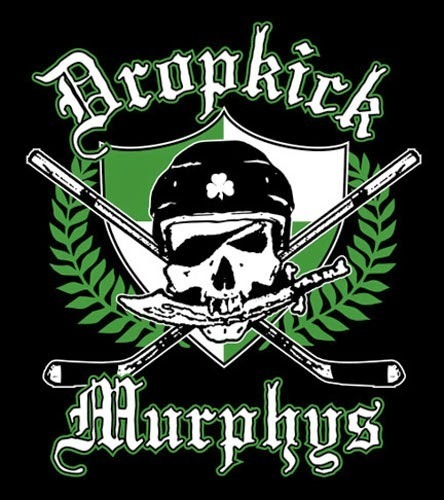
I actually collect pirate music, so I play The Rambling Sailors, Irish folk music by The Chieftains and The Dubliners, and a collection of sea shanties that I got from discs at the library. If you want something a little more exciting, you might try Irish Punk by the Pogues, Flogging Molly and the Dropkick Murphys. Or go pirate punk with Alestorm. Start Googling pirate music and you’ll be surprised.
Other activities? Liar’s Dice, the game that was played in POTC Dead Man’s Chest is a possibility, and there are many other pirate themed games, from Pirate Flux to Zombie Ninja Pirates. Don’t let your guests play poker, though. It wouldn’t be invented for a couple of hundred years.
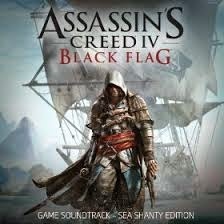
But the most favorite event at my parties is when we all sing sea shanties. It’s easy to get CD’s, or pull up some songs on YouTube. I print lyric cards and pass them out, and with a little encouragement, I’ve got a living room full of perfectly sober people singing sea shanties at the top of their lungs. And the next day everyone’s saying “I sang sea shanties at a pirate party!”
Of course, I have pirate-loving friends.
First: the Decorations
It so happens that, as a semi-professional pirate myself, I have a lot of piratical stuff. A couple of Megablocks pirate ships, Jack Sparrow posters, pirate flags, chests, and a lot of others, right down to my pirate rubber duck.

So it you love pirates, and you have this stuff, make sure it’s all out where people can see it.

But to buy new stuff for decorations, go to the second-hand store. First, stock up on fabric – second hand sheets, old lace, brocade and checked table cloths, patterned curtains. These are what you will use to cover up the modern stuff in your house that you can’t hide. Modern furniture, appliances, desks, all get hidden under a couple of layers of cloth. Why a couple? Because you don’t want to be neat. Use at least two layers, and make sure they don’t match and neither one is straight. You want it to look like someone just casually threw the cloth over what-ever-it-is.

I like to light most of my house with candles for effect, and this means no exposed flames (too dangerous) so the candles need to go inside glasses, jelly jars, anything that will protect your guests. (More stuff you can find in the second hand store.)
Be careful people! And if you want the effect, but not the fire, get the fake candles that operate off a small battery.

This is also where you get your serving trays and bowls, and the plates and cups your guests will use. Oh, sure, anyone can buy paper plates with a jolly roger on them. But when your guests are eating off a mish-mash of wooden salad bowls, fine china plates, and weird little silver or glass trays, and drinking out of beer steins, wine glasses and teacups, they’ll feel like they’re in the home of outlaws.
It’s also cheaper. I serve food off wooden cutting boards and salad bowls, glass punch bowls, cast iron pots, fine china serving pieces. All bought at next-to-nothing second hand.
I went on line and printed out large (11x17) versions of various pirate pictures, and framed them before hanging them up. Fishing nets (from Michaels craft store) add a nautical touch. I fill jewelry boxes with fake gold coins (party store) and garage-sale jewelry.
Food:
I love to feed my guests, but what’s appropriate pirate food? My theory is that pirates traveled all over, so I should try to have food from all the places that pirates hung out: a mix of Chinese, Mexican, French, Irish, African and North American food, with a little tropical thrown in for fun.

If you don’t cook, it could be: mini egg rolls (China), salsa, guacamole and chips (Mexico) French silk pie,(France) potato skins (“Irish”), popcorn (North America), tropical fruit salad (you can buy this canned, if you REALLY don’t make food), coconut cookies. And my favorite pirate food: Meat on a Stick. This is just chicken or pork, threaded on wooden skewers (from the grocery store) and grilled or baked. Barbecue sauce is perfectly acceptable, since both barbecue and buccaneer come from the same root word, which also gives us “bacon.” So throw some bacon in there as well.

Alcoholic punch was popular when pirates ruled the seas, so I always do punch, though mine has no alcohol. There are so many recipes you can surely find one that appeals to you. It’s different, which is what you’re aiming for here.
Pirates are exotic.
Partie Activities:
So what kind of exotic entertainments will you have at your pirate party? If you’ve got the kind of $$$$ that pays for entertainment at your events, by all means hire a belly dancer. Belly dancers and pirates are two great things that go great together.
But whatever you do, DO NOT play any of the Pirates of the Caribbean movies on the TV. Even with the sound off. I’ve seen this done twice, and both times everything stopped while the guests stared at the TV.
What you might want to show, with the sound off, is some OLD pirate movies. Disney’s Treasure Island. The Black Swan. Even (heaven help us) Cut Throat Island.

I actually collect pirate music, so I play The Rambling Sailors, Irish folk music by The Chieftains and The Dubliners, and a collection of sea shanties that I got from discs at the library. If you want something a little more exciting, you might try Irish Punk by the Pogues, Flogging Molly and the Dropkick Murphys. Or go pirate punk with Alestorm. Start Googling pirate music and you’ll be surprised.
Other activities? Liar’s Dice, the game that was played in POTC Dead Man’s Chest is a possibility, and there are many other pirate themed games, from Pirate Flux to Zombie Ninja Pirates. Don’t let your guests play poker, though. It wouldn’t be invented for a couple of hundred years.

But the most favorite event at my parties is when we all sing sea shanties. It’s easy to get CD’s, or pull up some songs on YouTube. I print lyric cards and pass them out, and with a little encouragement, I’ve got a living room full of perfectly sober people singing sea shanties at the top of their lungs. And the next day everyone’s saying “I sang sea shanties at a pirate party!”
Of course, I have pirate-loving friends.
Published on July 15, 2014 19:38
July 7, 2014
Rehabilitating a Spanish Galleon
My love of pirates is evident in all parts of my life, and very often my friends are kind enough to bring me little presents to celebrate my passion… A pair of earrings featuring ships in full sail, skull-and-crossbones bookmarks, a Jack Sparrow Pez dispenser.
So it wasn’t terrible unusual when my best friend announced “I’ve bought you a boat! Every pirate ought to have her own ship!” She was terribly excited. It was a Spanish galleon. She had bought it at a garage sale for practically nothing. It needed a little work…
Then she dragged it into the house. It was a horror.

Most of my readers are probably too young to remember a decorating style called “Mediterranean.” It mostly involved keeping the house as dim as possible, furnishing it with heavy, dark furniture, and using brass, burnt orange, dark red and gold colors. Most of the houses furnished in this style featured a statue of either a bullfighter, a conquistador, or a Spanish galleon. My new ship was one of these galleons.

That made it 40 years old, and it looked every day of it. It was covered with grime. It smelled bad. The sails were made out of some unknown substance, which was falling to bits, and which I had the feeling was giving me cancer as I looked at it.

But she was my best friend. And she was so excited. I accepted the ship with a smile, and promised to fix it up.
The first thing I did was to rip off all the decaying sails, and the second was to put the whole thing in the shower and give it a bath. When the water stopped running brown, I took it out, toweled it down, and re-attached all the bits that had fallen off. It had been put together with water-soluble glue. It now smelled considerably better.
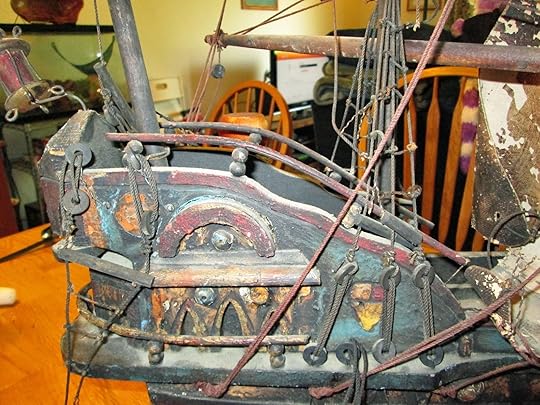
The next step was to cover the thing with some paint. The colors burgundy and green were represented on my galleon, under a layer of walnut stain, and I liked them, so I tripped out to Michaels craft store, and bought red, green and gold craft paint (real ships often had golden trim), and went to work.
Part way through, I confronted the fact that the ship’s cannons were not only completely out of proportion with the rest of the boat, but would be underwater if the vessel were ever to go to sea. I cut, chiseled and pried them off, then spackled them over.

It wasn’t a good job. I’m no sculptor. Fortunately, history said that the lower part of the ship should be protected with a layer of tar. A thick coat of black paint covered a multitude of sins.
The ship now smelled just fine, and looked a lot better. It was time to re-rig.
Most of the rigging on the original ship had been done by someone with a great deal of imagination, a staple gun, and no understanding at all about how a ship is rigged. My own understanding of this art is limited, but at least I know that lines are not supposed to be tied off below the waterline.

I bought 2 skeins of floss, a skein of yarn, took a book on ship rigging out of the library, and set to work. The rigging took maybe 40 hours, and some of it involved sewing the tiny knots together. I had to take some liberties – there was no place to tie off the lines, so I pounded in a few tiny nails and used those.
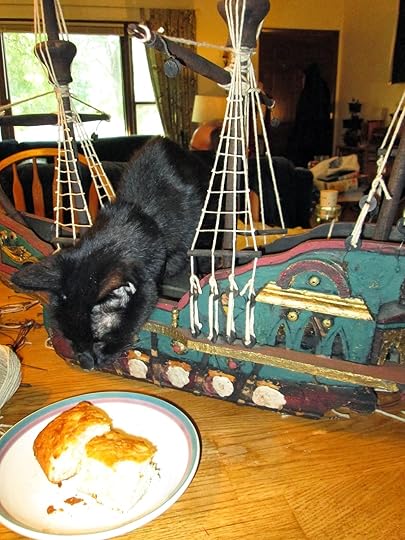 My dining room table. Cat for scale.
My dining room table. Cat for scale.
Intermingled with the lines, I began creating sails. The old ones were long gone, but I sew, so it wasn’t a terrible problem. Since I wanted the sails to belly out, I needed to stiffen the fabric. This was the hardest part… It took a lot of experimentation to figure out how to get an acceptable shape. (I ended up draping them over the plastic covering on a new roll of paper towels.) Each sail had to be stiffened separately, and the waiting was agony. In the meantime, I sewed rigging.

Real Spanish Galleons were often named after saints, and the portraits of the saints were painted on their sterns. It was one of the very attractive features of the ships. Not being a painter, either, I simply printed out a picture of a Spanish icon from the period, and glued it on the stern of the ship. And now she has a name – after the saint in the picture.
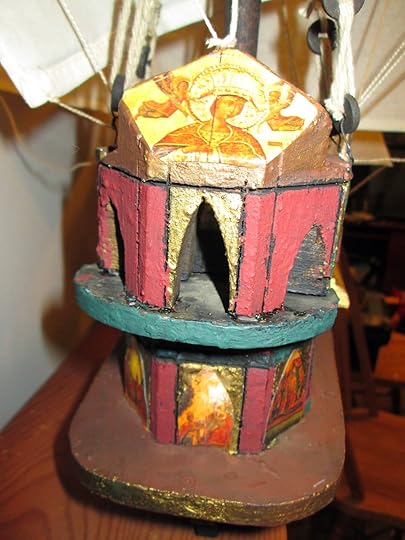
Finally it all came together. The sails went on. The last of the rigging went into place. I trimmed off lingering ends of string. (And trimmed. And trimmed.) She had become magnificent.
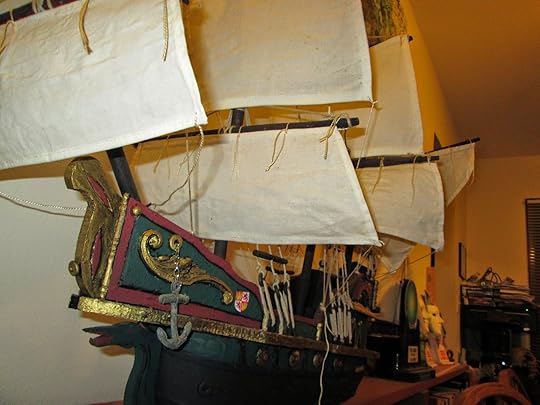
So, now I present to you the Santa Catalina de Alejandría, Spanish Galleon.
So it wasn’t terrible unusual when my best friend announced “I’ve bought you a boat! Every pirate ought to have her own ship!” She was terribly excited. It was a Spanish galleon. She had bought it at a garage sale for practically nothing. It needed a little work…
Then she dragged it into the house. It was a horror.

Most of my readers are probably too young to remember a decorating style called “Mediterranean.” It mostly involved keeping the house as dim as possible, furnishing it with heavy, dark furniture, and using brass, burnt orange, dark red and gold colors. Most of the houses furnished in this style featured a statue of either a bullfighter, a conquistador, or a Spanish galleon. My new ship was one of these galleons.

That made it 40 years old, and it looked every day of it. It was covered with grime. It smelled bad. The sails were made out of some unknown substance, which was falling to bits, and which I had the feeling was giving me cancer as I looked at it.

But she was my best friend. And she was so excited. I accepted the ship with a smile, and promised to fix it up.
The first thing I did was to rip off all the decaying sails, and the second was to put the whole thing in the shower and give it a bath. When the water stopped running brown, I took it out, toweled it down, and re-attached all the bits that had fallen off. It had been put together with water-soluble glue. It now smelled considerably better.

The next step was to cover the thing with some paint. The colors burgundy and green were represented on my galleon, under a layer of walnut stain, and I liked them, so I tripped out to Michaels craft store, and bought red, green and gold craft paint (real ships often had golden trim), and went to work.
Part way through, I confronted the fact that the ship’s cannons were not only completely out of proportion with the rest of the boat, but would be underwater if the vessel were ever to go to sea. I cut, chiseled and pried them off, then spackled them over.

It wasn’t a good job. I’m no sculptor. Fortunately, history said that the lower part of the ship should be protected with a layer of tar. A thick coat of black paint covered a multitude of sins.
The ship now smelled just fine, and looked a lot better. It was time to re-rig.
Most of the rigging on the original ship had been done by someone with a great deal of imagination, a staple gun, and no understanding at all about how a ship is rigged. My own understanding of this art is limited, but at least I know that lines are not supposed to be tied off below the waterline.

I bought 2 skeins of floss, a skein of yarn, took a book on ship rigging out of the library, and set to work. The rigging took maybe 40 hours, and some of it involved sewing the tiny knots together. I had to take some liberties – there was no place to tie off the lines, so I pounded in a few tiny nails and used those.
 My dining room table. Cat for scale.
My dining room table. Cat for scale.Intermingled with the lines, I began creating sails. The old ones were long gone, but I sew, so it wasn’t a terrible problem. Since I wanted the sails to belly out, I needed to stiffen the fabric. This was the hardest part… It took a lot of experimentation to figure out how to get an acceptable shape. (I ended up draping them over the plastic covering on a new roll of paper towels.) Each sail had to be stiffened separately, and the waiting was agony. In the meantime, I sewed rigging.

Real Spanish Galleons were often named after saints, and the portraits of the saints were painted on their sterns. It was one of the very attractive features of the ships. Not being a painter, either, I simply printed out a picture of a Spanish icon from the period, and glued it on the stern of the ship. And now she has a name – after the saint in the picture.

Finally it all came together. The sails went on. The last of the rigging went into place. I trimmed off lingering ends of string. (And trimmed. And trimmed.) She had become magnificent.

So, now I present to you the Santa Catalina de Alejandría, Spanish Galleon.
Published on July 07, 2014 17:03
June 30, 2014
Pirate Trivia
Striped Socks
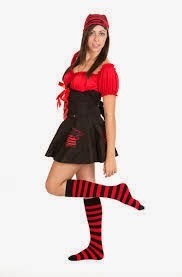 Yes, pirates wore stripey socks! 300 years ago, there were a lot of laws about what kind of clothes working-class people could wear. The type of fabric, the color, even the amount that went into a single garment was controlled by “sumptuary laws.” The rich didn’t want anyone to “get above their station” by dressing too nicely!
Yes, pirates wore stripey socks! 300 years ago, there were a lot of laws about what kind of clothes working-class people could wear. The type of fabric, the color, even the amount that went into a single garment was controlled by “sumptuary laws.” The rich didn’t want anyone to “get above their station” by dressing too nicely!
One of the few things that was not controlled was socks. So when a pirate first came into some money, he often went out and bought the most expensive pair of socks he could find – knee-high, brightly colored, and often striped.
To the people of the time, it gave the same impression as the uber-expensive hoodies worn by today’s gangsters.
How big was a pirate ship?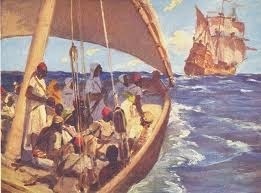
Everyone imagines pirate ships as being huge, square-masted, and carrying hundreds of guns. Movies like the Pirates of the Caribbean franchise just enhance this image. In fact, most pirate ships were small, nimble sloops and schooners with triangular sails.
While pirates robbed anyone they could catch, the proper proportions between a pirate ship and a merchant vessel was the same as between a wolf and a cow. And the pirates were just as likely to form a group in order to attack lager prey.
The merchants handed over their goods to the pirates for the same reason people give their money to a nervous teenager with a knife. Anything can happen, and suddenly it becomes apparent that there are things much more important than money.
Pirates and private property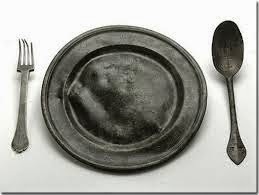
One of the perks of being a pirate was a chance to own some basic household goods. Unlike regular sailors, pirates owned several changes of clothes, plates, and even silverware. The remains of sunken pirate ships have turned up pewter dishes with the names of their owners proudly – if crudely - engraved on them.
Often sailors on merchant ships were forced to eat out of common buckets, using their hands.
Silk ribbons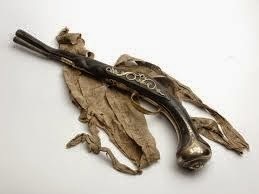 Pirates improved the smooth wooden grips on their pistols by wrapping them in silk ribbon. And in order to carry more than two at a time, they tied pairs of pistols together with longer ribbons, then draped them over their shoulders.
Pirates improved the smooth wooden grips on their pistols by wrapping them in silk ribbon. And in order to carry more than two at a time, they tied pairs of pistols together with longer ribbons, then draped them over their shoulders.
No one ever said it looked too feminine. Wonder why?
Blackbeard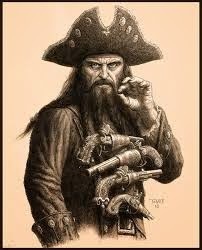 Although he cultivated a fearsome reputation, the pirate Blackbeard never harmed any of his captives… In fact, the only deaths or injuries proven to be caused by Blackbeard were during his final battle, when he was attacked by the British Navy.
Although he cultivated a fearsome reputation, the pirate Blackbeard never harmed any of his captives… In fact, the only deaths or injuries proven to be caused by Blackbeard were during his final battle, when he was attacked by the British Navy.
Not so privileged
Not only were pirate captains elected by their crews, but they lacked most of the perks assumed by navy and merchant captains. In fact, a pirate captain could not usually even count on privacy in his own cabin. Most ships had rules stating that anyone had the right to barge into the captain’s cabin whenever they wanted.
Tortuga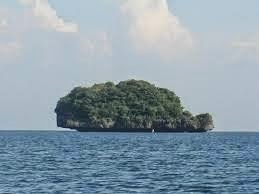
The name of the famous pirate haunt is simply the Spanish word for “Turtle.” There are several islands by this name in the Caribbean. Some were named because their shape looked like the dome of a turtle’s shell, others because sea turtles laid eggs there.
Davy Jones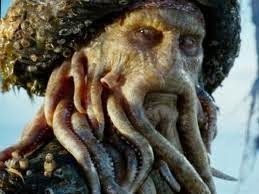 The name “Davy Jones” does not refer to a person, either real or fictional. It is simply a seaman’s slang for the devil. Going to “Davy Jones’ Locker” meant that when you died, you weren’t going to heaven.
The name “Davy Jones” does not refer to a person, either real or fictional. It is simply a seaman’s slang for the devil. Going to “Davy Jones’ Locker” meant that when you died, you weren’t going to heaven.
Walking the plank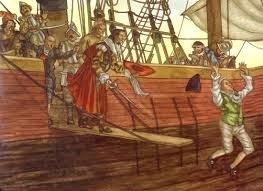
Pirates may have thrown some of their prisoners overboard, but they never imagined making them walk the plank. It’s an entirely fictional idea dreamed up by a penny-novelist trying to sell adventure books. But, after pirates had read some of the stories, they began to practice the ritual. They’d read it in a book; it must be true.
Saucy SadieA female river-pirate named Sadie the Goat (for her habit of head-butting her opponents in a fight) got into a scuffle with an equally tough lady, a six-foot-tall bouncer named Gallius Mag. Mag won the fight by biting Sadie’s ear off, and kept the ear as a souvenir.
Years later, the women met again and became friends. Mag gave Sadie the ear back, and Sadie wore it on a chain around her neck for the rest of her life.
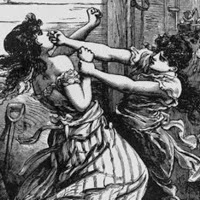
 Yes, pirates wore stripey socks! 300 years ago, there were a lot of laws about what kind of clothes working-class people could wear. The type of fabric, the color, even the amount that went into a single garment was controlled by “sumptuary laws.” The rich didn’t want anyone to “get above their station” by dressing too nicely!
Yes, pirates wore stripey socks! 300 years ago, there were a lot of laws about what kind of clothes working-class people could wear. The type of fabric, the color, even the amount that went into a single garment was controlled by “sumptuary laws.” The rich didn’t want anyone to “get above their station” by dressing too nicely!One of the few things that was not controlled was socks. So when a pirate first came into some money, he often went out and bought the most expensive pair of socks he could find – knee-high, brightly colored, and often striped.
To the people of the time, it gave the same impression as the uber-expensive hoodies worn by today’s gangsters.
How big was a pirate ship?

Everyone imagines pirate ships as being huge, square-masted, and carrying hundreds of guns. Movies like the Pirates of the Caribbean franchise just enhance this image. In fact, most pirate ships were small, nimble sloops and schooners with triangular sails.
While pirates robbed anyone they could catch, the proper proportions between a pirate ship and a merchant vessel was the same as between a wolf and a cow. And the pirates were just as likely to form a group in order to attack lager prey.
The merchants handed over their goods to the pirates for the same reason people give their money to a nervous teenager with a knife. Anything can happen, and suddenly it becomes apparent that there are things much more important than money.
Pirates and private property

One of the perks of being a pirate was a chance to own some basic household goods. Unlike regular sailors, pirates owned several changes of clothes, plates, and even silverware. The remains of sunken pirate ships have turned up pewter dishes with the names of their owners proudly – if crudely - engraved on them.
Often sailors on merchant ships were forced to eat out of common buckets, using their hands.
Silk ribbons
 Pirates improved the smooth wooden grips on their pistols by wrapping them in silk ribbon. And in order to carry more than two at a time, they tied pairs of pistols together with longer ribbons, then draped them over their shoulders.
Pirates improved the smooth wooden grips on their pistols by wrapping them in silk ribbon. And in order to carry more than two at a time, they tied pairs of pistols together with longer ribbons, then draped them over their shoulders.No one ever said it looked too feminine. Wonder why?
Blackbeard
 Although he cultivated a fearsome reputation, the pirate Blackbeard never harmed any of his captives… In fact, the only deaths or injuries proven to be caused by Blackbeard were during his final battle, when he was attacked by the British Navy.
Although he cultivated a fearsome reputation, the pirate Blackbeard never harmed any of his captives… In fact, the only deaths or injuries proven to be caused by Blackbeard were during his final battle, when he was attacked by the British Navy.Not so privileged

Not only were pirate captains elected by their crews, but they lacked most of the perks assumed by navy and merchant captains. In fact, a pirate captain could not usually even count on privacy in his own cabin. Most ships had rules stating that anyone had the right to barge into the captain’s cabin whenever they wanted.
Tortuga

The name of the famous pirate haunt is simply the Spanish word for “Turtle.” There are several islands by this name in the Caribbean. Some were named because their shape looked like the dome of a turtle’s shell, others because sea turtles laid eggs there.
Davy Jones
 The name “Davy Jones” does not refer to a person, either real or fictional. It is simply a seaman’s slang for the devil. Going to “Davy Jones’ Locker” meant that when you died, you weren’t going to heaven.
The name “Davy Jones” does not refer to a person, either real or fictional. It is simply a seaman’s slang for the devil. Going to “Davy Jones’ Locker” meant that when you died, you weren’t going to heaven.Walking the plank

Pirates may have thrown some of their prisoners overboard, but they never imagined making them walk the plank. It’s an entirely fictional idea dreamed up by a penny-novelist trying to sell adventure books. But, after pirates had read some of the stories, they began to practice the ritual. They’d read it in a book; it must be true.
Saucy SadieA female river-pirate named Sadie the Goat (for her habit of head-butting her opponents in a fight) got into a scuffle with an equally tough lady, a six-foot-tall bouncer named Gallius Mag. Mag won the fight by biting Sadie’s ear off, and kept the ear as a souvenir.
Years later, the women met again and became friends. Mag gave Sadie the ear back, and Sadie wore it on a chain around her neck for the rest of her life.

Published on June 30, 2014 19:43
June 23, 2014
How to Know a Pirate When You Meet Him
Imagine that you are back in the Golden Age of Piracy, in or about the Caribbean. Everyone is wearing funny old clothes, like they did 300 years ago, and they all speak using old fashioned words. If you’ve been reading this blog for a while you know that pirates didn’t walk around with eye-patches, peg-legs and parrots. So if you ran into a pirate, how would you recognize him?
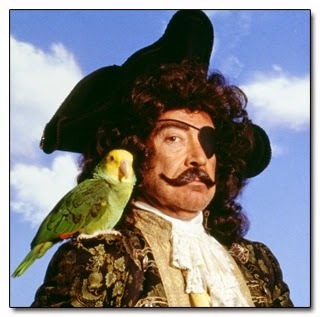
To begin with, all pirates were sailors, so first you would notice if he was one of those. This would be pretty easy to tell. Sailors walked with a wide-legged stance, and a sort of swagger to their steps. Both were caused by spending so much time on the deck of a moving ship. Learning to walk this way was part of “getting your sea legs.” When sailors first came on shore, they staggered around as if on a moving platform. It took a while to get used to walking on something (the ground) that didn’t move.
Second, sailors had their own vocabulary. Every item on the ship had a name, from directions like “port” and “starboard” to the “puddening” on a mast, or the orlop deck below. If the fellow you’ve just met tells you to “Heave off, you lubber, or you’ll be splicing your teeth in the bilge,” you know he probably sails boats for a living.
Lastly, sailors wore very particular work clothes. I go into the details here: pirate clothes but basically they were loose, pale colored pants, colorful shirts and coats that were almost always blue. Pirates wore the same clothes, but with a bit of a twist.
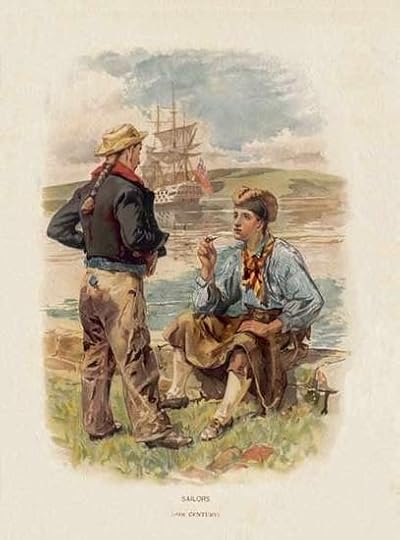
Pirates clothes were made the same way - the cut of the clothing was practical - but with the addition of much richer material. The eighteenth century was not a time to be subtle. If you had money, you wore it. A pirate, who needed work clothes, would still have them made out of the richest material around… stolen Chinese silks, brocades from England, spangled cottons form India.
To the people of the time, it would have been like one of us seeing a construction worker wearing Carhartt overalls made out of expensive suit material. You’d notice a thing like that.

Pirates were also noted for having very nice coats, but horrible, raggedy looking pants. The coats they stole from rich men. But the cut of a rich man’s tight breeches wouldn’t do for people who worked for a living. And face it, pirating a blue-collar work. So they wore the grand coats and their own pants.
In a tavern, pirates were loud. Ordinary sailors drank their drinks, sang and danced a little, and tried to stay out of trouble. Pirate banged on the tables, complained (loudly) if the service wasn’t to their liking, and had opinions about what the music should be like. This noisy, assertive behavior was unusual enough that they often frightened tavern-keepers who weren’t used to pirates.
Tavern keepers who were used to pirates were happy to see the pirates and to take the money. All sailors were noted for “spending money like rainwater.” Pirates outdid them in spades. In six weeks of pirating, a man could earn as much as a regular sailor could earn in two years, and they tended to spend it just as quickly.
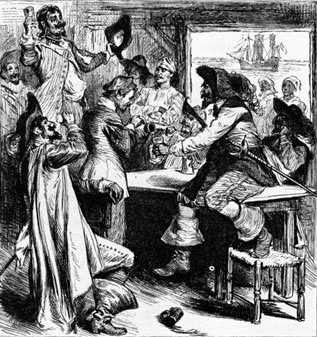
Because of this, pirates on land had followers who admired them so much, they could be called fans. They were richly and exotically dressed. They wanted to have a good time. And they were willing to pay for it. People crowded around them to drink the drinks the pirates bought, hear the stories they told, and sell them things that they might need.
In what might otherwise be a quiet, backwater town, this was the only excitement available.
And lastly, pirates hung out with people far above their “station in life.” Their ships brought in tons of stolen goods and they needed to sell them. To do this, they needed to deal with rich men, and the rich men were happy to oblige. This kind of under-the-table business dealing was almost respectable in the New World. Major families built empires off the profits they made dealing with pirates.
And as the pirating went on… And on… And on… The pirates and the merchant became quite close. Blackbeard was good friends with the Governor of North Carolina, and supposedly married into one of the First Families of the region. Ben Hornigold was hired to teach pirating methods to the heir of a trading family.

The family of the famous Scottish nationalist and preacher James Guthrie ended up on Black Island, near the pirate haven of New Providence. There they made of fortune trading in stolen goods. James’ granddaughter Mary married a friend of Captain Kidd, and the two of them helped to hide some of Kidd’s ill-gotten gains.
In short, pirates and rich merchants went together like peanut butter and chocolate.
So if you were back in the early 1700’s and met a man wearing a very fine coat and hat, and ragged old sailor’s pants, who spent money like water and attracted star-struck admirers, and who was keeping company with the finest families in the area, while drinking in the ordinary taverns during the day, you could be pretty sure he was a pirate.
And if you wanted to make sure, you could always ask, “Are you member of the sweet trade?”


To begin with, all pirates were sailors, so first you would notice if he was one of those. This would be pretty easy to tell. Sailors walked with a wide-legged stance, and a sort of swagger to their steps. Both were caused by spending so much time on the deck of a moving ship. Learning to walk this way was part of “getting your sea legs.” When sailors first came on shore, they staggered around as if on a moving platform. It took a while to get used to walking on something (the ground) that didn’t move.
Second, sailors had their own vocabulary. Every item on the ship had a name, from directions like “port” and “starboard” to the “puddening” on a mast, or the orlop deck below. If the fellow you’ve just met tells you to “Heave off, you lubber, or you’ll be splicing your teeth in the bilge,” you know he probably sails boats for a living.
Lastly, sailors wore very particular work clothes. I go into the details here: pirate clothes but basically they were loose, pale colored pants, colorful shirts and coats that were almost always blue. Pirates wore the same clothes, but with a bit of a twist.

Pirates clothes were made the same way - the cut of the clothing was practical - but with the addition of much richer material. The eighteenth century was not a time to be subtle. If you had money, you wore it. A pirate, who needed work clothes, would still have them made out of the richest material around… stolen Chinese silks, brocades from England, spangled cottons form India.
To the people of the time, it would have been like one of us seeing a construction worker wearing Carhartt overalls made out of expensive suit material. You’d notice a thing like that.

Pirates were also noted for having very nice coats, but horrible, raggedy looking pants. The coats they stole from rich men. But the cut of a rich man’s tight breeches wouldn’t do for people who worked for a living. And face it, pirating a blue-collar work. So they wore the grand coats and their own pants.
In a tavern, pirates were loud. Ordinary sailors drank their drinks, sang and danced a little, and tried to stay out of trouble. Pirate banged on the tables, complained (loudly) if the service wasn’t to their liking, and had opinions about what the music should be like. This noisy, assertive behavior was unusual enough that they often frightened tavern-keepers who weren’t used to pirates.
Tavern keepers who were used to pirates were happy to see the pirates and to take the money. All sailors were noted for “spending money like rainwater.” Pirates outdid them in spades. In six weeks of pirating, a man could earn as much as a regular sailor could earn in two years, and they tended to spend it just as quickly.

Because of this, pirates on land had followers who admired them so much, they could be called fans. They were richly and exotically dressed. They wanted to have a good time. And they were willing to pay for it. People crowded around them to drink the drinks the pirates bought, hear the stories they told, and sell them things that they might need.
In what might otherwise be a quiet, backwater town, this was the only excitement available.
And lastly, pirates hung out with people far above their “station in life.” Their ships brought in tons of stolen goods and they needed to sell them. To do this, they needed to deal with rich men, and the rich men were happy to oblige. This kind of under-the-table business dealing was almost respectable in the New World. Major families built empires off the profits they made dealing with pirates.
And as the pirating went on… And on… And on… The pirates and the merchant became quite close. Blackbeard was good friends with the Governor of North Carolina, and supposedly married into one of the First Families of the region. Ben Hornigold was hired to teach pirating methods to the heir of a trading family.

The family of the famous Scottish nationalist and preacher James Guthrie ended up on Black Island, near the pirate haven of New Providence. There they made of fortune trading in stolen goods. James’ granddaughter Mary married a friend of Captain Kidd, and the two of them helped to hide some of Kidd’s ill-gotten gains.
In short, pirates and rich merchants went together like peanut butter and chocolate.
So if you were back in the early 1700’s and met a man wearing a very fine coat and hat, and ragged old sailor’s pants, who spent money like water and attracted star-struck admirers, and who was keeping company with the finest families in the area, while drinking in the ordinary taverns during the day, you could be pretty sure he was a pirate.
And if you wanted to make sure, you could always ask, “Are you member of the sweet trade?”

Published on June 23, 2014 18:42



